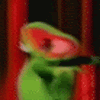Immediately upon starting the first book today, I knew this
Storytime was in trouble. LOTS of squirrely kids, a few criers—This group was
NOT WITH ME. It was glaringly obvious that the kids have been cooped up for
days with our subzero temperatures. So I decided to blog the process of how I
kept it together!
Here was my plan: (Yes, I color code. It gives me a quick visual on the balance of storytime activities. I also normally only read three of four planned books).
Theme: Night
(Opening Song) 1, 2, 3
(Book) When Sheep Sleep by
Numeroff
Letter of the day with Fergus (LINK)
Count People--Parent message about counting higher than
three five or ten
(Song/chant) Twinkle Twinkle Little Star—twinkle
fingers for first part, wave arms overhead for second part
(Action activity/fingerplay) Here
is a cup (LINK)
(Book) Shhhhhh! Everybody’s
Sleeping by Markes
(Flannel Story) Five in the
Bed (LINK)
(Fingerplay) This is my right
hand (LINK)
(Book) Cornelius P. Mud, Are You Ready for Bed by Saltzberg
(Book) Who Said Coo? by Ruddell
Sleeping Sleeping All the Children Sleeping Learned from this page on Perpetual Preschool, and you can see Mel's version here.
(Closing Song) Storytime is over now/See you later (tune of London Bridge)
Hand Stamp
And here’s what I did. The red indicates all the
decisions I made on the fly.
(Opening Song) 1, 2, 3—
(Book) When Sheep Sleep by Numeroff
I tried to make the book more interactive by adding animal
sounds or motions on each page, but that wasn’t enough. So I skipped a few
pages to get to the end.
Next, I knew that we’d have to get some serious wiggles out
for this storytime to work. I needed to convince the kids that I was super fun
and worth listening to for the next 25 minutes! I decided to just do directed
movements so I could get a good gauge on the group. “Ok everybody stand up and reach waaaaay up high. Wiggle
those fingers. Now stretch your arms way out to the side. Now clap them
together in front of you. Now stretch them out to the side annnnnnnnd...CLAP.
Stretch them out to the side annnnnnnnnnd…CLAP. Clap fast! Clap slooooow.
Great. Now let your hands fall to the side and clap over your head. Again! I did lots of repeating here and different
commands to get them focused on me and following along. I made it suspenseful
and pretty soon they were giggling and listening well.
Once I had them with me I did started the “Show me five” game
I like to play before starting a fingerplay. “Show me five (hold out hand with fingers out). Hide them! (ball fist).
Fiiiiiiiiive—hide them! FIVE! THREE! Did I fool you? Five!” I do this several times, varying fast and
slow and how many fingers I want to see. They love it. I most often use this to
move into “Five Fat Peas” which I do as a full body motion fingerplay. We did
Five Fat Peas three times before moving on to the Letter of the Day.
Letter of the day with Fergus
Count People—Parent message about counting higher than
three five or ten
(Song/chant) Twinkle Twinkle—twinkle fingers for first
part, wave arms overhead for second part
(Action activity/fingerplay) Here is a cup
(Book) Shhhhhh! Everybody’s Sleeping (On each spread we put our finger to our lips
and said shhhhhh)
(Flannel Story) Five in the Bed
(Fingerplay) This is my right hand
We went as planned for a while, but by the time we finished
the fingerplay above many of them were spontaneously standing, and I realized
they had been sitting for a while and were definitely not ready for a book. So I
added one of our regular action activities, “I Can Jump Jump Jump” but I
expanded it this time to include fast/slow versions of each movement to expend
more energy. THEN we were ready to listen to our next book.
(Book) Cornelius P. Mud Who Said Coo?
I switched the book here to Who Said Coo? Since Cornelius is
more of a ‘list’ type story similar to Shhhhhhhh! Everybody’s Sleeping and I
knew that Who Said Coo’s more cohesive plot and repetitive refrain would draw the kids in more.
(Action activity/fingerplay) Oliver Twist
Sleeping Sleeping: All the Children Sleeping—bumblebees,
snowflakes, dogs, pigs, horses
Hand Stamps!
And there it is. It turned out to be a very successful storytime with 58 attendees.




















